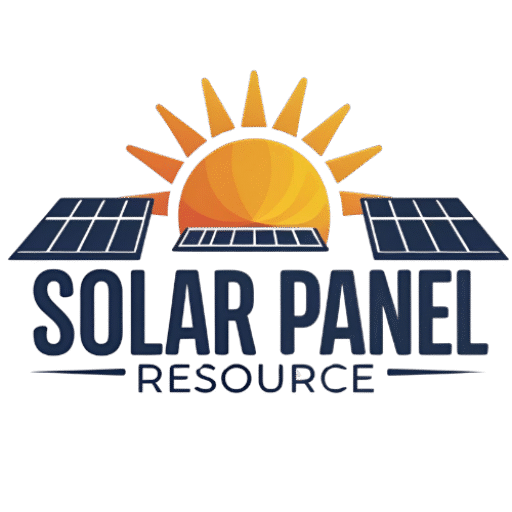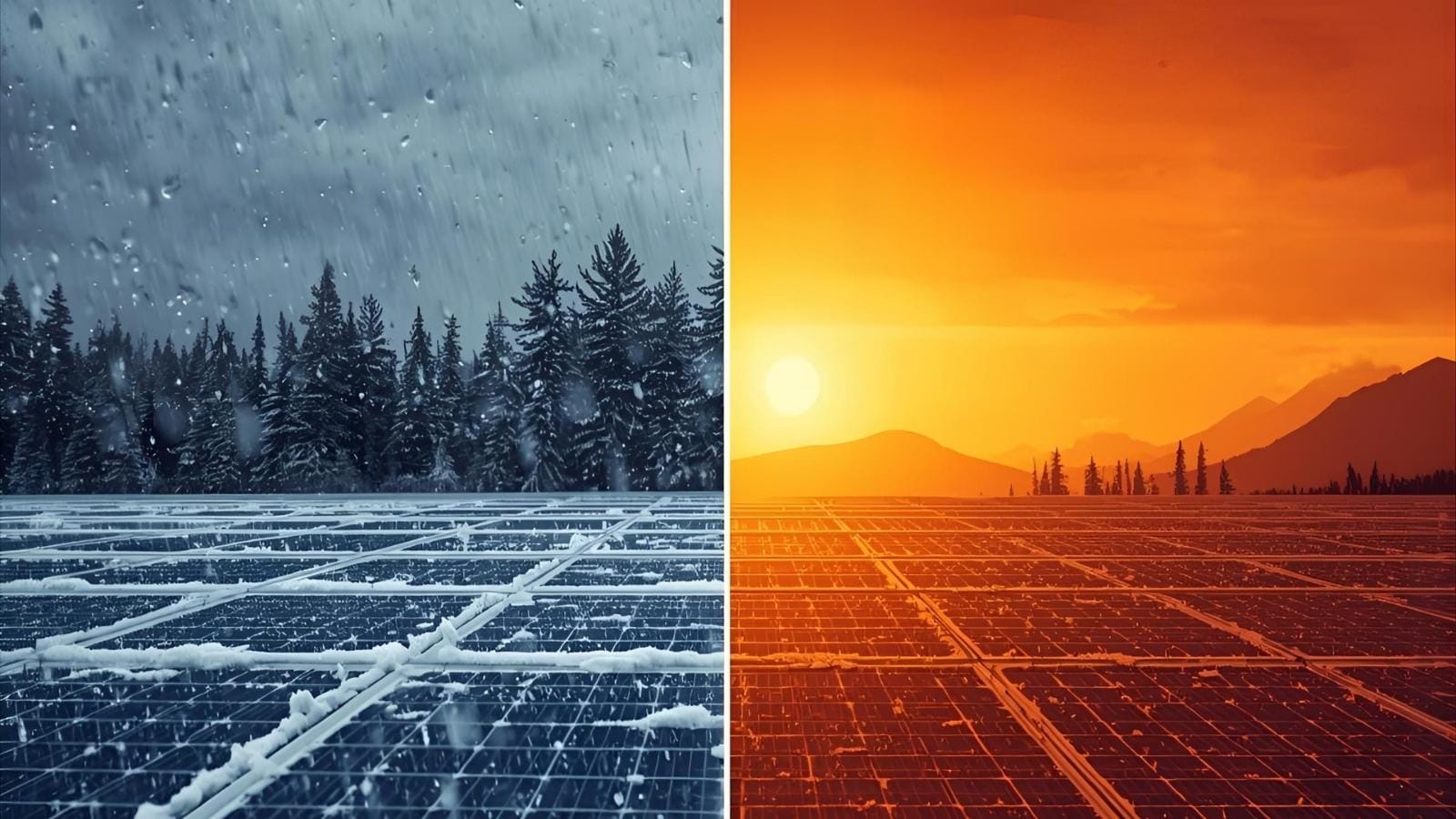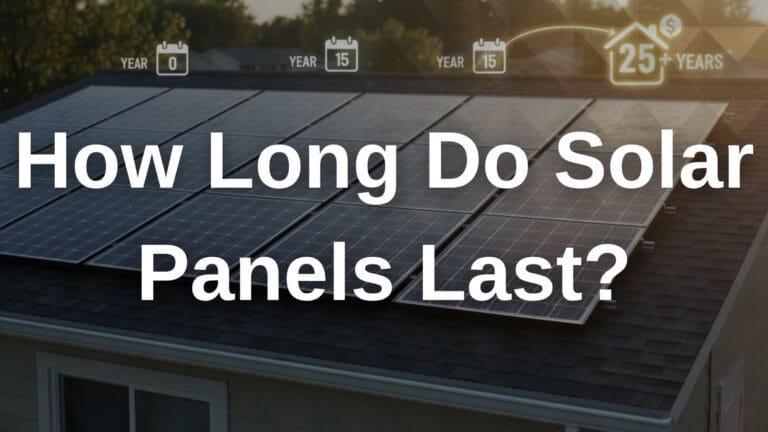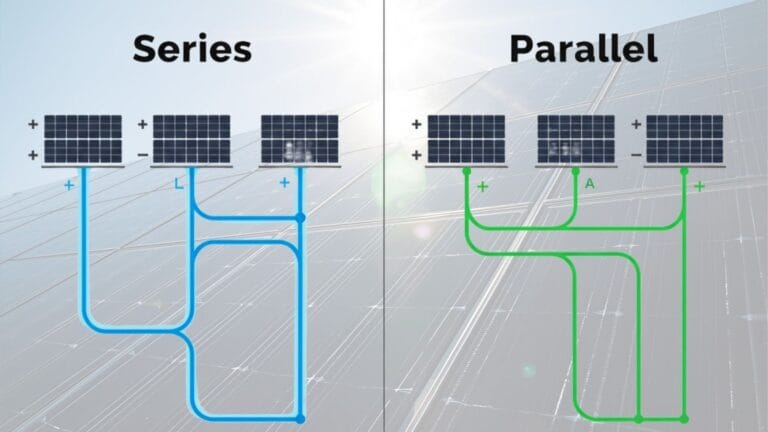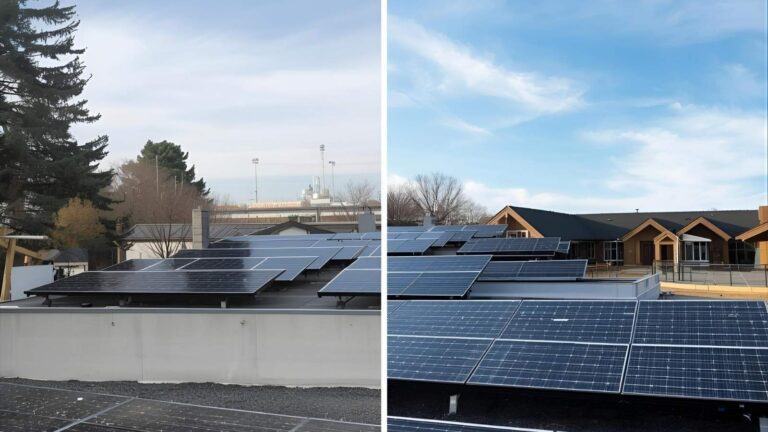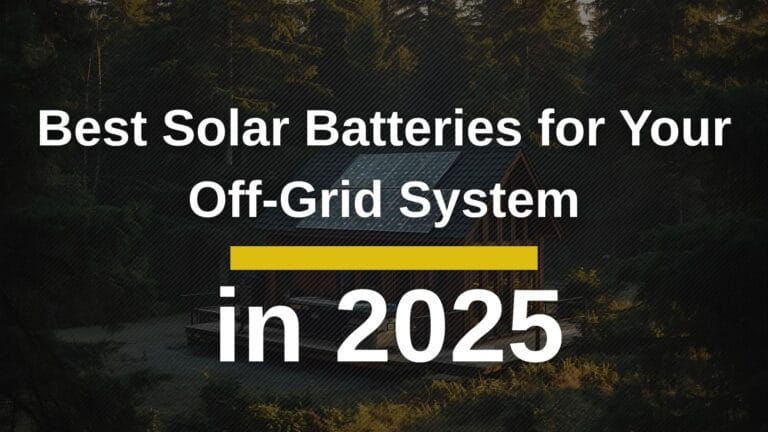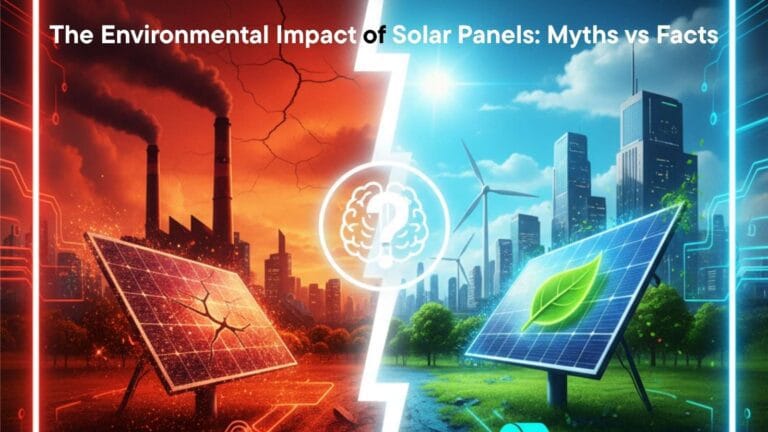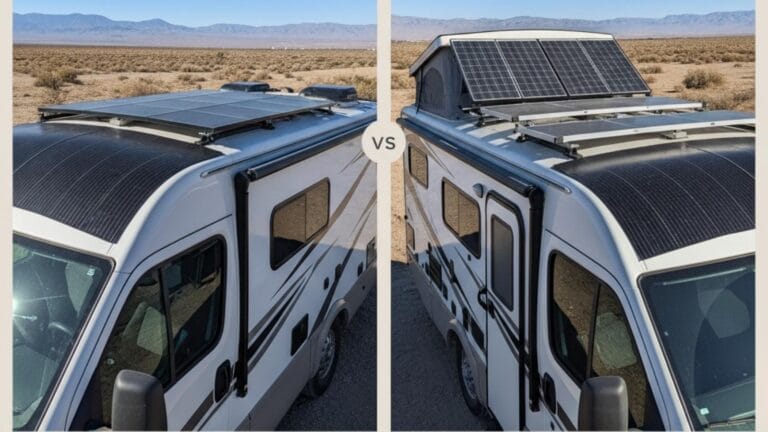Do Solar Panels Work in Snow, Rain, and Extreme Heat?
Solar panels are engineered to be incredibly durable, but their performance is far from static. Understanding how different weather conditions impact your system is key to making a smart investment and having realistic expectations for its energy production. A professional-level analysis goes beyond simply looking at a sunny day and considers the real-world factors that affect your system’s output all year round.
1. The Reality of Rain and Cloud Cover
It’s a common misconception that solar panels are useless on cloudy or rainy days. In reality, they continue to produce power. Panels can generate electricity from diffuse sunlight, which is the light that still reaches the earth through cloud cover. While their output may drop to 10-25% of peak capacity, they are not completely shut down.
Rain can actually be a benefit! It acts as a natural cleaning agent, washing away dust, pollen, and other debris that can accumulate on your panels and reduce their efficiency. However, in polluted areas, rain may leave behind mineral deposits, so a professional cleaning is still recommended periodically to maintain peak performance.
2. The Impact of Extreme Heat
While it may seem counterintuitive, solar panels are actually less efficient at high temperatures. Solar panels are tested at a standard temperature of 25°C (77°F). For every degree Celsius above this, a panel’s output slightly decreases. This is known as the temperature coefficient. While a hot, sunny day still produces more energy than a cold, cloudy one, a cool, sunny day is often ideal for maximum efficiency.
Proper installation is key to mitigating this effect. An expert installer will mount panels with a small gap between them and the roof to allow for convective cooling, which helps air circulate and keeps the panels from overheating.
3. Conquering the Cold and Snow
Winter brings shorter days and less direct sunlight, but it can also present a unique challenge: snow cover. A thick layer of snow can block sunlight from reaching your panels, but a light dusting often allows enough diffuse light to pass through for some energy generation.
Fortunately, solar panels are designed to shed snow naturally. Their smooth, dark surface and the tilt of the roof help to melt and slide off snow. In regions with heavy snowfall, an installer may recommend a steeper tilt angle to encourage snow shedding. High-quality panels are also built to withstand the weight of heavy snow loads, a durability factor that is guaranteed by the product’s warranty.
How Solar Panels Perform in Snow
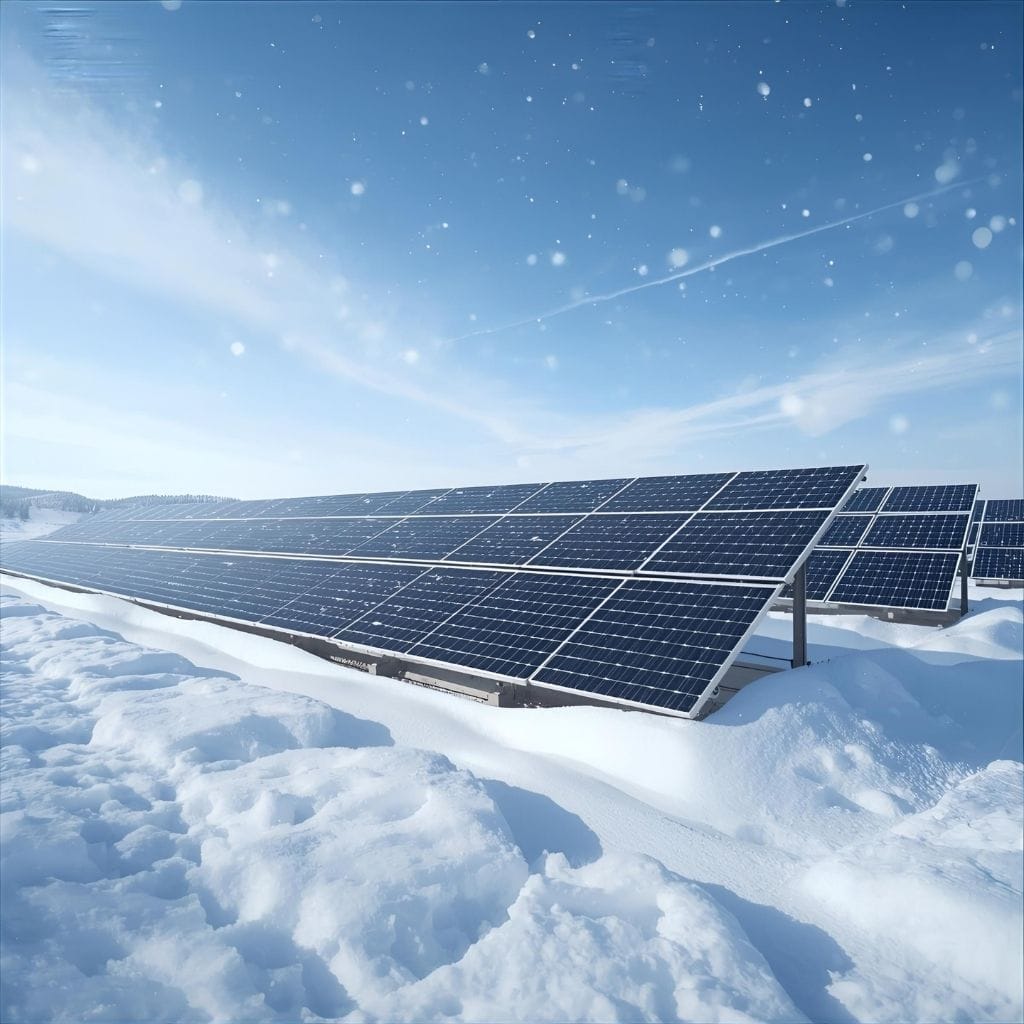
You don’t have to live in a sunny, dry climate to go solar. In fact, some of the most efficient solar markets are in places with cold, snowy winters. Understanding how solar panels perform in these conditions is key to a successful investment.
The Technical Reality of Snow
While it seems counterintuitive, snow can be both a friend and a foe to your solar system.
- Snow as a Foe: The primary drawback of snow is its ability to block sunlight. If a panel is completely covered, it cannot produce power. However, it’s important to know that solar panels require sunlight, not heat, to function. A thin, powdery layer of snow may allow some light to pass through, resulting in a reduced but not entirely zero output.
- Snow as a Friend: When the panels clear, snow actually helps boost their efficiency. This is due to two key phenomena:
- The Albedo Effect: Fresh, white snow is highly reflective. A blanket of snow on the ground acts like a giant mirror, reflecting sunlight and increasing the amount of light that reaches your panels. This can result in a significant boost in energy production, especially when the sun is low in the sky during winter months.
- Cold Temperature Advantage: Solar cells operate more efficiently at lower temperatures. This is because cold temperatures reduce the electrical resistance of the cells, allowing them to convert sunlight into electricity more effectively. As a result, a clear, crisp winter day can be one of the best times of the year for peak energy production.
Expert Recommendations for Winter Performance
To maximize your system’s performance and ensure its longevity in a snowy climate, professionals recommend these best practices:
Safe Clearing Methods: If you need to manually clear a heavy snow load, it’s crucial to use the right tools. Use a soft-headed roof rake or a broom with foam bristles to gently pull the snow off. Never use a metal shovel or hard tool, as it can scratch or crack the glass, permanently damaging the panel and voiding your warranty.
Optimal Tilt Angle: During installation, an expert installer will angle your panels at a steeper tilt (typically 30°–45° in snowy climates). This allows gravity to work for you, helping the snow to slide off the slick glass surface naturally. This is the most effective and low-maintenance way to keep your panels clear.
Solar Panel Efficiency During Rain
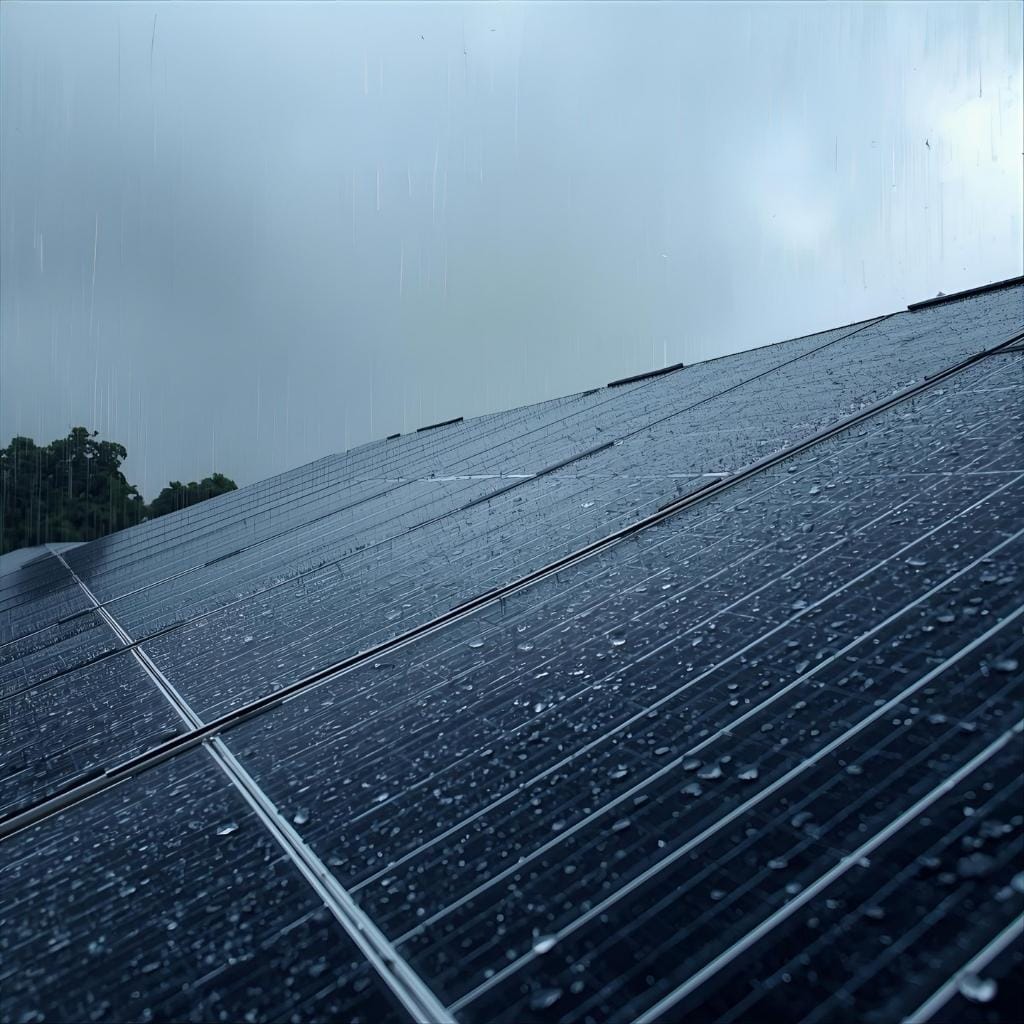
While a bright, sunny day is ideal for solar production, your solar panels are designed to operate—and even thrive—in diverse weather conditions. Understanding how they perform on a rainy day is key to setting realistic expectations and appreciating the full value of your investment.
The Science of “Cloudy Day” Power
Solar panels don’t just rely on direct sunlight; they also use diffuse light, which is the light scattered by clouds and atmospheric particles. This is why even on a heavily overcast day, your panels will continue to produce power. While their output will be lower, a professional-grade system can still generate 10–25% of its peak capacity. This is because modern panels, especially monocrystalline ones, are highly efficient at converting low-intensity light into electricity.
Rain: The Natural Cleaner and Cooler
Rain offers a unique benefit that directly impacts your system’s performance.
Reduced Overheating: Solar panel efficiency is inversely related to temperature. On a hot, sunny day, a panel’s output can decrease slightly due to heat. The cooler conditions that come with rain, however, prevent this thermal loss, helping your panels operate at a higher efficiency.
Natural Cleaning: Rainwater acts as a free, natural cleaning agent. As it runs down the smooth glass surface, it helps to wash away dust, pollen, and other debris that can accumulate over time and reduce your system’s efficiency. While it may not remove stubborn grime like bird droppings, regular rainfall is highly effective at maintaining panel cleanliness, especially in less polluted areas.
Impact of Extreme Heat on Solar Panels

While it may seem counterintuitive, solar panels are actually less efficient in extreme heat. Understanding this relationship is key to ensuring your system delivers maximum performance, especially if you live in a hot climate.
The Science Behind Heat and Efficiency
Solar panels are rated for performance at a standardized temperature of 25°C (77°F). As a panel’s temperature increases, its power output decreases. This is measured by the temperature coefficient, a crucial metric that indicates how much efficiency is lost for every degree Celsius above the standard. A lower temperature coefficient means the panel will perform better in the heat. For example, a panel with a coefficient of -0.3% will lose less power than one with a coefficient of -0.5% under the same high-temperature conditions.
Premium solar panels often use advanced cell technologies (like N-type TOPCon or Heterojunction) that have a lower temperature coefficient, making them a smarter investment for hot climates.
Mitigating Heat for Maximum Production
A professional installer uses strategic techniques to keep your panels as cool as possible and prevent heat-related losses.
High-Quality Materials: Reputable manufacturers use durable materials that are less susceptible to degradation from heat over time. Choosing panels from a trusted brand with a robust warranty is a wise way to ensure your system’s longevity and performance in extreme conditions.
Proper Airflow: One of the most effective ways to manage heat is through ventilation. Installers mount panels with a gap of several inches between the back of the panel and the roof. This creates an air channel that allows for convective cooling, where hot air rises and escapes, keeping the panels’ operating temperature down.
Roof Material: The color of your roof can also play a role. Light-colored roofs reflect more sunlight and absorb less heat, which can help keep the panels from getting too hot from below.
Common Misconceptions About Weather and Solar Panels
Many misconceptions about solar energy stem from a misunderstanding of how solar panels interact with different types of weather. Let’s separate the myths from the facts to set clear and realistic expectations for your system’s performance all year round.
Myth: Solar panels stop working entirely in bad weather.
Fact: Solar panels are incredibly resilient and can still generate electricity on cloudy, rainy, or overcast days. While it may seem like they need bright, direct sunlight to function, they also absorb and convert diffuse light—the sunlight that passes through and is scattered by clouds.
While their output will be reduced (typically to 10-25% of their peak capacity), they are not completely idle. Rain also serves a valuable purpose by naturally washing away dust and debris, a maintenance benefit that keeps your panels clean and their efficiency high.
Myth: Cold climates are unsuitable for solar.
Fact: A cold, sunny day is often the most ideal condition for solar panel performance. The common assumption that solar panels need heat to work is false; they only need sunlight. Solar cells operate more efficiently in cooler temperatures because colder conditions reduce the electrical resistance within the cells, allowing electrons to flow more easily.
While snow can temporarily block light, most panels are designed to shed snow naturally due to their smooth surface and the tilt of the roof. Furthermore, a layer of fresh snow on the ground can actually boost production by reflecting sunlight onto your panels—a phenomenon known as the albedo effect.
Myth: Heat always increases energy production.
Fact: Excessive heat can actually lower a solar panel’s power output. This is a crucial point for homeowners in hot climates. Solar panels are rated at a standard temperature of 25°C. For every degree Celsius above this, a panel’s output can drop by 0.3% to 0.5%, depending on the panel’s temperature coefficient.
This is why proper installation and equipment choice are so important. An expert installer will ensure adequate airflow behind the panels to prevent overheating, and premium panels with a lower temperature coefficient will experience less of an efficiency loss on sweltering days.
Best Practices for Maximizing Output in Extreme Conditions
Building a resilient solar system that performs well in all seasons requires careful planning and the right strategies. Based on a deep dive into industry data and expert recommendations, here are the key tactics that professionals use to ensure your solar investment pays off, rain or shine.
1. Strategic Installation
A skilled installer knows that a solar system’s performance is highly dependent on its physical setup.
- Optimal Angle and Ventilation: Panels are installed at a precise angle to maximize sunlight absorption throughout the year. In snowy climates, this angle is often steeper (30-45°) to help snow naturally slide off the panels. In hot climates, the angle and a proper gap behind the panels are critical to ensure sufficient airflow, which prevents overheating and maintains efficiency.
- High-Quality Materials: Choosing panels with a low temperature coefficient and a high durability rating is essential. This ensures that the panels can withstand extreme heat without significant power loss and are strong enough to endure severe weather events like hail.
2. Advanced Technology and Coatings
Modern solar technology offers a range of innovations that help panels stand up to the elements.
- Anti-Reflective and Hydrophobic Coatings: Many high-quality panels are treated with special coatings. An anti-reflective coating helps the panel absorb more light, while a hydrophobic (water-repelling) coating causes water to bead up and run off the surface. This has a dual benefit: it helps the panels shed rain and snow more easily, and it also carries away dust and debris, keeping the panels cleaner for longer.
3. Smart Maintenance and Monitoring
Your solar journey is a partnership with a professional installer who can provide guidance on the maintenance your system needs.
- Seasonal Inspections: While solar systems require very little hands-on maintenance, a professional can perform a seasonal inspection to check for any potential damage from extreme weather. They will look for signs of stress from ice, hail, or heat and ensure all components are functioning optimally.
- Performance Monitoring: Your installer will set up a monitoring system so you can track your energy production. By monitoring your system’s output, you can quickly identify any drops in performance that may indicate an issue that needs to be addressed, giving you peace of mind that your investment is always working for you.
Navigating the world of solar can be challenging, but understanding how your system performs in different weather conditions is essential for making a sound investment. A professionally designed system goes beyond just sunny days, ensuring you get consistent, reliable power all year round.
The All-Season Solar Advantage
Modern solar panels are engineered to be resilient, performing in a wide range of conditions. While environmental factors like snow and heat will influence your system’s output, a savvy homeowner knows that with the right approach, these effects can be significantly mitigated.
- A System for Every Climate: In hot, sunny regions, a professional installer will prioritize panels with a low temperature coefficient and ensure proper ventilation to prevent efficiency losses. In snowy climates, they’ll use a steeper tilt angle and durable mounting hardware to promote natural snow shedding. This customized approach ensures your system is perfectly suited to your local environment.
- The Power of Technology: Choosing high-quality, high-efficiency panels is a strategic decision. These panels perform better in low-light conditions, ensuring you get more power on cloudy or rainy days. This, along with advanced system designs, turns potential weaknesses into consistent performance.
A Smart Investment for a Resilient Future
Ultimately, solar energy is about more than just technology; it’s about a long-term investment in your home and your future. By choosing the right system, panels, and installation partner, you are building a resilient energy source that will:
- Deliver Consistent Energy: Despite fluctuations in the weather, your system is designed to provide reliable energy, reducing your reliance on the grid and leading to predictable savings.
- Provide a Higher ROI: A well-planned and well-maintained system will produce more electricity over its lifetime, ensuring a faster payback period and a higher return on your investment.
By understanding the technical limitations and applying these best practices, you can have confidence that your solar panels will be a powerful and effective energy solution for decades to come. For more insights on maximizing your system’s lifespan, read our detailed guide on how long solar panels last and how to extend their life
Reference: Solar Energy Technologies Office (SETO) research

Solar Energy Enthusiast & Renewable Energy Researcher
Vural’s journey into solar energy began four years ago, driven by frequent power outages and high electricity bills at his own home. He has since gained hands-on experience with both personal and commercial solar projects. At solarpanelresource.com, Vural shares his real-world insights and in-depth research to guide homeowners and business owners on their own path to energy independence.
